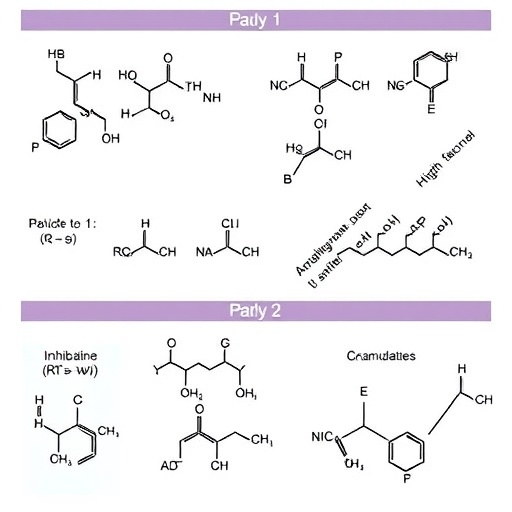The ongoing battle against respiratory syncytial virus (RSV), a major cause of respiratory illness in infants and the elderly, has precipitated a surge of research aimed at discovering novel antiviral compounds. A recent study authored by Xie et al. explores innovative strategies using benzimidazole derivatives as potential inhibitors of the RSV fusion protein. This protein is pivotal for viral entry into host cells, making it a compelling target for therapeutic intervention. The research not only identifies promising compounds but also employs rigorous computational methods such as quantitative structure-activity relationship (QSAR) modeling, molecular docking, and absorption, distribution, metabolism, excretion, and toxicity (ADMET) evaluations.
Benzimidazole derivatives have long been recognized for their diverse pharmacological profiles, which include antifungal, anti-inflammatory, and antiviral activities. Their structural versatility allows for significant modifications that can enhance bioactivity and selectivity. Xie et al. leverage this characteristic by synthesizing a library of benzimidazole derivatives, setting the stage for high-throughput screenings aimed at identifying candidates that can effectively disrupt the RSV fusion process. This approach epitomizes the intersection of synthetic chemistry and computational biology in modern drug discovery.
The QSAR methodology employed in this study serves as a powerful predictive tool to establish relationships between chemical structure and biological activity. By analyzing various physicochemical properties of the benzimidazole derivatives, the researchers were able to construct predictive models that offer insights into how specific structural features correlate with antiviral efficacy. This data-driven approach minimizes experimental bottlenecks and accelerates the identification of lead compounds.
Molecular docking simulations play a crucial role in the computational assessment of binding affinities between the synthesized compounds and the RSV fusion protein. The study harnesses advanced docking algorithms to visualize and predict the mode of interaction between the antiviral agents and their target protein. These insights not only bolster the understanding of the binding interactions but also guide the design of more potent inhibitors, an essential step in the drug development pipeline.
One of the study’s most notable features is its comprehensive ADMET profiling, which evaluates the pharmacokinetic properties of the candidate compounds. Assessing the absorption, distribution, metabolism, excretion, and toxicity of these molecules is vital to ensuring their viability as therapeutic agents. Potential inhibitors that show promising antiviral activity must also possess favorable ADMET characteristics to predict their success in clinical settings.
Through meticulous experimentation and analysis, Xie et al. have delineated several benzimidazole derivatives that exhibit significant inhibitory activity against RSV. These findings represent a substantial step forward in antiviral therapeutics, particularly given the limited options currently available for treating RSV infections. The study underscores the potential for repurposing existing chemical frameworks, like benzimidazoles, to expedite the discovery process for new antiviral agents.
Importantly, the research community recognizes the urgency for novel RSV therapeutics due to rising incidence rates and the impact of COVID-19 on healthcare systems worldwide. In such a context, the findings of Xie et al. not only answer a critical need but also open avenues for subsequent research that could lead to effective treatments for both RSV and other respiratory viruses.
The rigorous scientific methodology used in this study adds credibility to its conclusions. By intertwining experimental results with computational predictions, the researchers provide a robust framework for the development of antiviral drugs. This integrative approach not only enhances the precision of drug design but also paves the way for future innovations in antiviral research.
The study also highlights the necessity for collaborative efforts among various scientific disciplines. Combining expertise from medicinal chemistry, pharmacology, and computational biology leads to a more holistic understanding of drug action and resistance mechanisms. Such interdisciplinary collaboration is essential in addressing complex challenges presented by viral infections, especially in a rapidly evolving landscape.
A notable aspect of the research is its implication for global health; as RSV remains a leading cause of morbidity and mortality, effective antiviral therapies could have a profound impact. Ensuring that these findings translate to practical treatments will rely on continuous investment in both research and development, as well as successful navigation of the regulatory landscape.
Additionally, the study serves as a reminder of the importance of innovation in drug design. Traditional methods of drug discovery can be time-consuming and costly, but the synergy of QSAR modeling and molecular docking offers a pathway to streamline the process. By reducing dependence on trial-and-error, researchers can focus their resources on the most promising candidates, thus optimizing the chances of success in clinical trials.
In summary, the work of Xie et al. represents a beacon of hope in the search for effective RSV treatments. By exploring the potential of benzimidazole derivatives through a comprehensive methodology that includes QSAR, molecular docking, and ADMET evaluations, the authors set the stage for a new era of antiviral drug development. As public health challenges persist, studies such as this one are crucial in the quest to mitigate the burden of viral infections and improve patient outcomes.
The implications of this research extend beyond the immediate target of RSV. The methodologies employed could be adapted to explore other viral pathogens, creating a flexible framework for future antiviral drug design. As the scientific community rallies to address infectious disease threats, the findings of this study could inspire a new wave of antiviral discovery focused on structural analogs that effectively target various viral machineries.
In light of the ongoing challenges presented by respiratory viruses, the predictive power of computational methodologies alongside traditional experimental approaches can expedite the translation of academic research into clinical applications. As researchers continue to unravel the complexities of viral pathology, it is critical that studies like the one conducted by Xie et al. are supported and amplified, facilitating a concerted response to emerging viral threats on a global scale.
Amidst the ongoing discourse on the strategies for combating respiratory infections, Xie et al.’s work stands out as a significant contribution. As new methodologies evolve and the scientific terrain shifts, the continuous exploration of novel compounds—rooted in the principles of medicinal chemistry and informed by computational insights—will be integral to shaping future therapies that can effectively target viral infections.
Subject of Research: Discovery of potential RSV fusion protein inhibitors from benzimidazole derivatives using QSAR, molecular docking, and ADMET evaluation methods.
Article Title: Discovery of potential RSV fusion protein inhibitors from benzimidazole derivatives using QSAR, molecular docking, and ADMET evaluation methods.
Article References:
Xie, Y., Jia, R., Fan, T. et al. Discovery of potential RSV fusion protein inhibitors from benzimidazole derivatives using QSAR, molecular docking, and ADMET evaluation methods.
Mol Divers (2025). https://doi.org/10.1007/s11030-025-11360-x
Image Credits: AI Generated
DOI: https://doi.org/10.1007/s11030-025-11360-x
Keywords: RSV, antiviral, benzimidazole derivatives, QSAR, molecular docking, ADMET.
Tags: ADMET evaluations in pharmacologyantiviral drug discoverybenzimidazole derivativescomputational biology in medicinehigh-throughput screening methodsmolecular docking techniquespharmacological profiles of benzimidazolesQSAR modeling in drug designrespiratory syncytial virus researchRSV inhibitorssynthetic chemistry innovationstherapeutic targets for RSV





